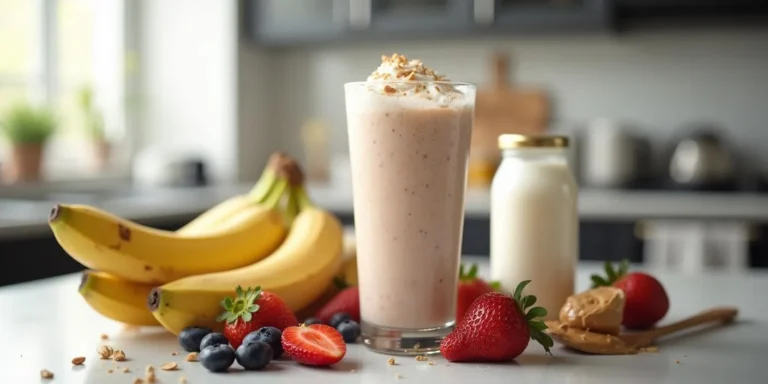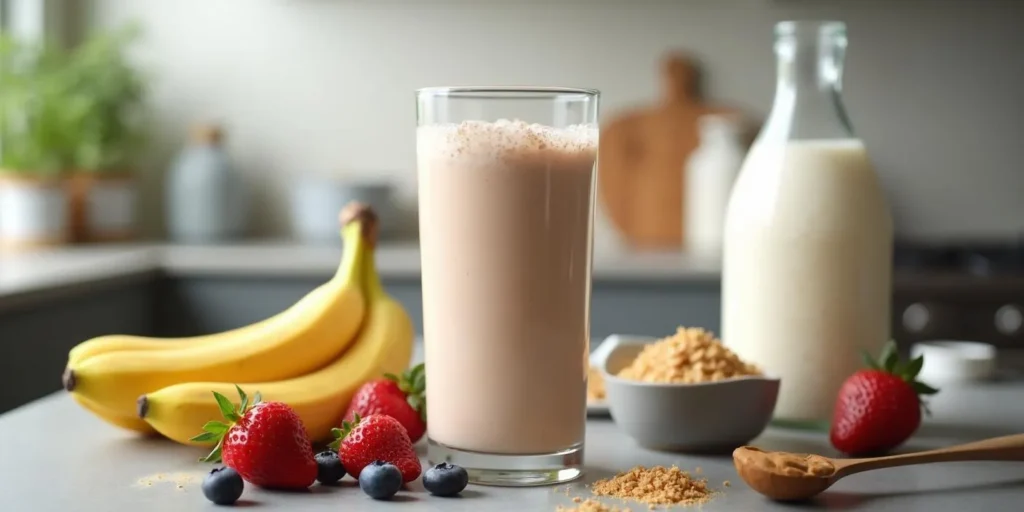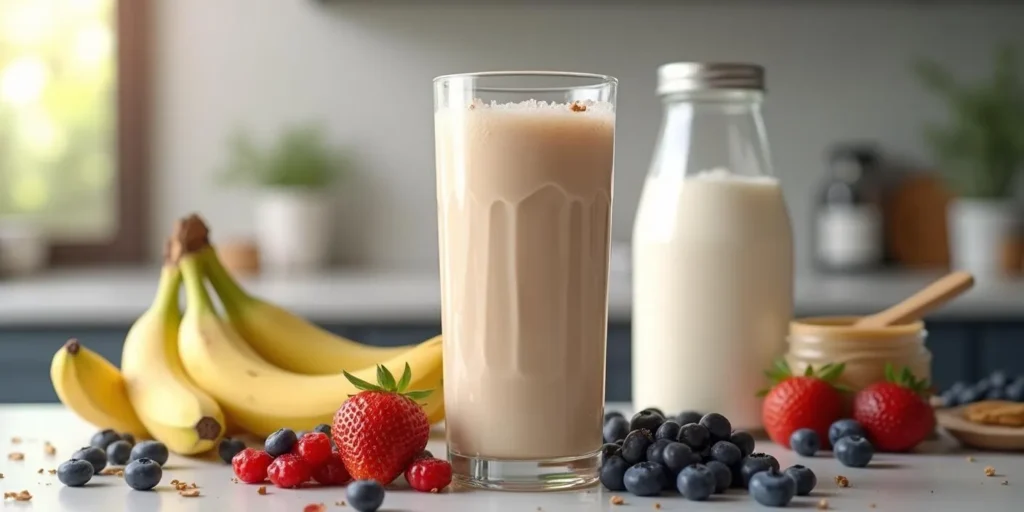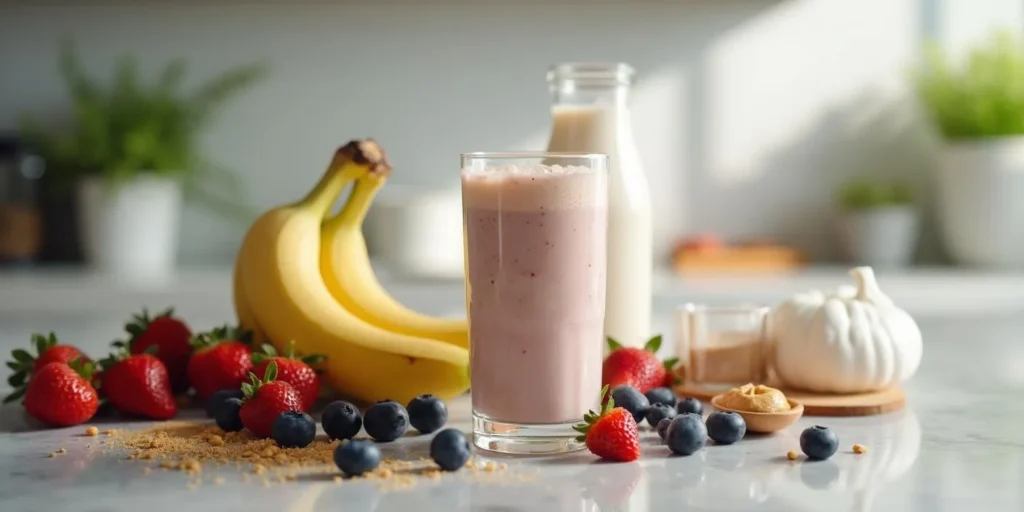
Protein powder is one of the most popular supplements for muscle growth, weight loss, and overall health. However, simply mixing it with water can result in a bland, chalky texture that’s hard to enjoy. That’s why many people wonder, what is the best thing to mix with protein powder?
By choosing the right liquids, fruits, healthy fats, and superfoods, you can enhance not only the taste and texture but also the nutritional value of your protein shake. Whether you’re looking for a post-workout recovery drink, a meal replacement shake, or a nutritious breakfast smoothie, this comprehensive guide covers the best mix-ins for protein powder, ensuring you get the most benefits from your protein intake.

Table of Contents
Table of Contents
Why Mixing Protein Powder Correctly Is Essential
Simply scooping protein powder into water or milk and giving it a shake might not be the best approach. Properly mixing protein powder has several benefits:
- Better Taste – Many protein powders have a chalky, grainy texture that can be improved with the right mix-ins.
- Improved Digestion – Some ingredients help enhance absorption and reduce bloating or discomfort.
- Increased Satiety – Adding fiber, healthy fats, and complex carbohydrates makes your shake more filling.
- Boosted Nutrition – Certain ingredients enhance vitamins, minerals, and antioxidants, making your shake a nutrient powerhouse.
- Smoother Texture – Clumps in your shake can be avoided with the right blending techniques and mix-ins.
If you’re looking for the perfect protein shake recipe, understanding the best ingredients to mix with protein powder will help you create a delicious and nutritious shake that supports your fitness and health goals.
Best Liquids to Mix with Protein Powder
The first step to making a great protein shake is choosing the right liquid base. Your choice of liquid affects taste, texture, and nutrient content.
1. Water – The Low-Calorie and Fastest Option
Mixing protein powder with water is the simplest, most convenient, and lowest-calorie option.
✅ Pros:
- Zero calories, making it perfect for weight loss and cutting phases
- Fast digestion, ideal for post-workout recovery
- No added sugars or fats, which is beneficial for clean eating plans
❌ Cons:
- Lacks creaminess and taste compared to other liquids
- May not provide enough nutrients if used as a meal replacement
Although water is convenient, many people prefer other liquid options to enhance their protein shake experience.
2. Milk and Dairy Alternatives – Creamier and More Nutritious
Mixing protein powder with milk or dairy-free alternatives creates a smoother, creamier texture and enhances the taste significantly.
Cow’s Milk (Whole, Skim, or Low-Fat)
Cow’s milk naturally enhances protein intake, as it contains 8 grams of protein per cup. It’s also rich in:
- Calcium and Vitamin D for bone health
- Healthy fats (whole milk) for extra energy
- A natural sweetness that improves flavor
For those who are lactose intolerant or follow a vegan diet, plant-based alternatives are excellent choices.
Plant-Based Milk Options
- Almond Milk – Low in calories and has a mild, nutty flavor.
- Soy Milk – High in protein (comparable to dairy milk), great for muscle recovery.
- Oat Milk – Naturally sweet, making protein shakes more flavorful.
To make your shake more interesting, consider mixing protein powder with almond milk or oat milk, which offers a better taste than plain water while still being light and easy to digest.
For tips on making a silky smooth protein shake, check out these expert recommendations.

Best Fruits and Vegetables to Mix with Protein Powder
Fruits and vegetables not only enhance the flavor of protein shakes but also add fiber, antioxidants, and essential vitamins.
3. Best Fruits for Protein Shakes
Adding fruits helps to create a naturally sweet, nutrient-packed shake. The best options include:
- Bananas – Creamy, naturally sweet, and packed with potassium, which helps prevent muscle cramps.
- Berries (Strawberries, Blueberries, Raspberries) – High in antioxidants, low in sugar, and great for heart health.
- Pineapples & Mangoes – Provide tropical flavors and natural digestive enzymes.
Using frozen fruits instead of fresh ones creates a thicker, colder shake, eliminating the need for ice.
4. Adding Vegetables for Extra Nutrients
If you want to boost your protein shake’s nutritional value, adding vegetables is an excellent option. Some of the best vegetables to mix include:
- Spinach – Adds iron and vitamin K while being virtually tasteless.
- Kale – High in fiber, antioxidants, and helps support detoxification.
- Zucchini – Makes shakes extra creamy without altering flavor.
Blending greens into protein shakes is a simple and effective way to increase vegetable intake without noticing the taste.
Healthy Fats to Mix with Protein Powder
Adding healthy fats ensures longer-lasting energy and enhances satiety.
5. Nut Butters and Seeds
Nut butters and seeds improve protein shake consistency while providing essential nutrients.
Best Nut Butters:
- Peanut Butter – Classic, protein-rich, and high in healthy fats.
- Almond Butter – Contains vitamin E and magnesium, great for muscle recovery.
Top Healthy Seeds:
- Chia Seeds – Absorb liquid, making shakes thicker, and are rich in omega-3s.
- Flaxseeds – Great for heart health and digestion.
For extra fiber and protein, adding chia or flaxseeds is an easy way to make your shake more nutritious.
Special Additions to Mix with Protein Powder
6. Coffee and Matcha – Energy and Antioxidants
If you love coffee, mixing protein powder with cold brew or matcha tea provides both protein and caffeine for an energizing boost.
- Coffee + Protein Powder – A great pre-workout drink that fuels morning energy.
- Matcha + Protein Powder – High in antioxidants, offers sustained energy.
For more ideas, check out these protein coffee recipes.

Final Thoughts: What’s the Best Thing to Mix with Protein Powder?
Experimenting with different mix-ins ensures that your protein shake is nutritious, delicious, and satisfying. Whether you prefer simple options like water and milk or nutrient-packed additions like fruits, oats, and nuts, the key is to find a balance that suits your goals.
For more protein-packed recipes, check out our Best Protein Powder Recipes and healthy lunch ideas here.
Now it’s time to start mixing! Try these combinations and find your perfect protein shake.
FAQs About Mixing Protein Powder
What is best to mix with protein powder?
The best mix-ins for protein powder depend on your goals and preferences. For a creamy texture and extra protein, mix it with milk or Greek yogurt. If you want a low-calorie option, use water or almond milk. To enhance flavor and nutrition, add fruits (bananas, berries), nut butters, oats, or seeds.
What is protein powder usually mixed with?
Protein powder is commonly mixed with:
Water – The easiest, lowest-calorie option.
Milk (Dairy or Plant-Based) – Enhances flavor and creaminess.
Smoothies – Mixed with fruits, vegetables, and superfoods.
Oats or Yogurt – Creates a protein-packed meal.
Coffee or Matcha – Provides an energy boost and protein together.
What not to mix protein powder with?
Avoid mixing protein powder with:
Sugary Juices – Can cause blood sugar spikes and may mask the protein benefits.
Boiling Hot Liquids – Can cause clumping and affect texture.
Carbonated Drinks – Creates excessive foaming and an unpleasant texture.
Artificial Sweeteners & Excess Sugar – Can lead to digestive discomfort.
What’s the best way to drink protein powder?
The best way to drink protein powder is by blending it with liquid and nutrient-dense ingredients for better taste and digestion. For post-workout recovery, mix it with water or milk. For a meal replacement, blend it into a smoothie with fruits, nuts, and oats. Use a shaker bottle or blender to ensure a smooth, clump-free texture.
